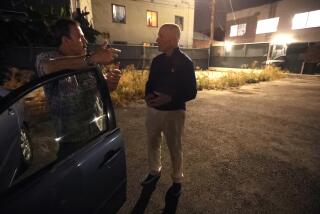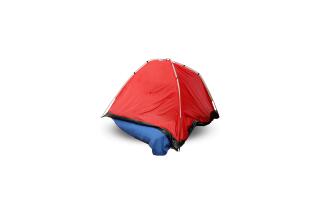How can we help the homeless? Let’s start by asking them
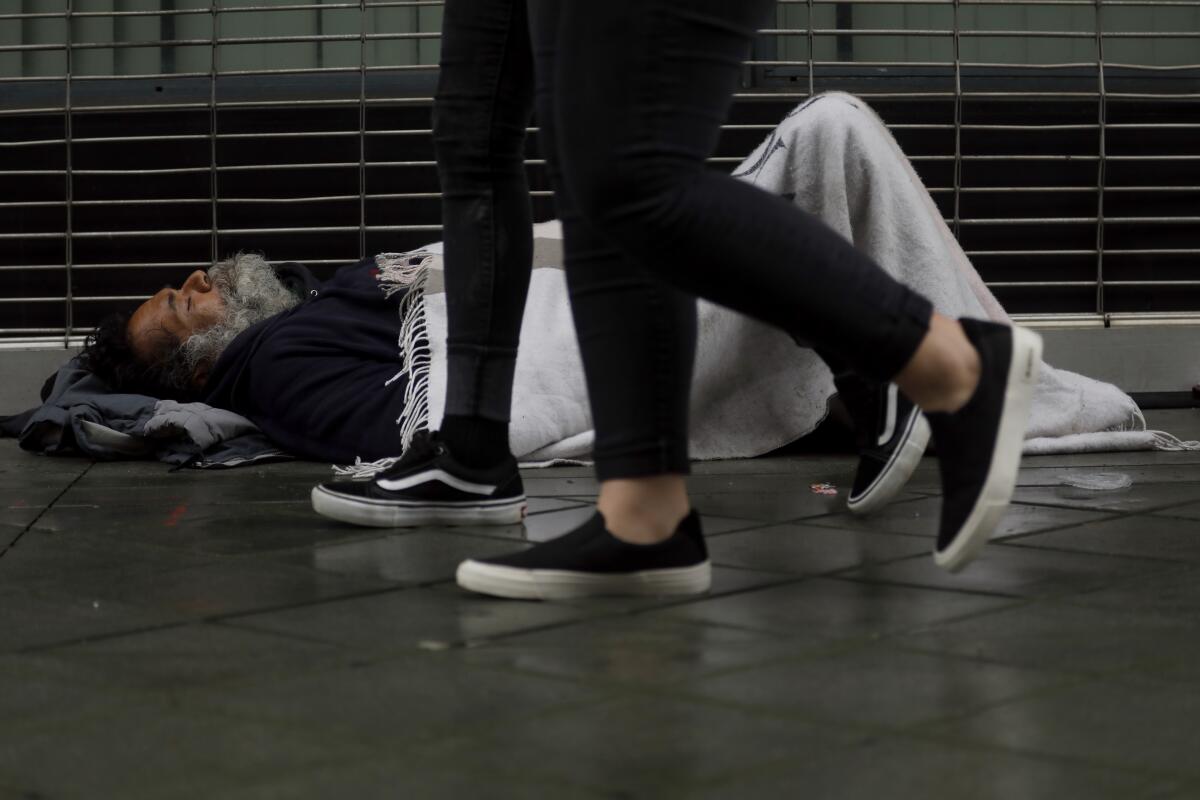
I had some questions I needed answered so I went in search of experts, not in nonprofit or government offices but on a dirt slope beside the southbound 101, in an alley off Fairfax Avenue, at a scraggly encampment on a trash-strewn block in Van Nuys.
The giant numbers keep flashing in my head: At last count, more than 36,000 homeless people were living in Los Angeles, nearly 59,000 in the county. So many efforts of so many kinds are underway to help, but you don’t have to be good at math to know there aren’t enough outreach workers to reach every person.
I keep saying that we, as individuals, have to jump in with direct help too.
But how? How to start? What is useful? What comforts? What nuts-and-bolts, practical aid can we offer? Readers keep asking me these questions. I keep asking them of myself.
It only makes sense, my own gut and people who already do this tell me, to pose the questions to those living and hoping not to die on our streets.
On Van Nuys Boulevard, I asked a too-thin woman, too thinly clothed for the cool day, and waited it out as her too-rapid thoughts flitted and flickered, like fireflies in the dark. She was wearing a tank top, a very light cardigan, worn-out jeans. Her bare feet were in flip flops. When she finally landed on my questions, she was blunt.
She said she doesn’t understand why people donate their clothes to thrift shops, which sell them, instead of bringing them to people like her who have nothing.
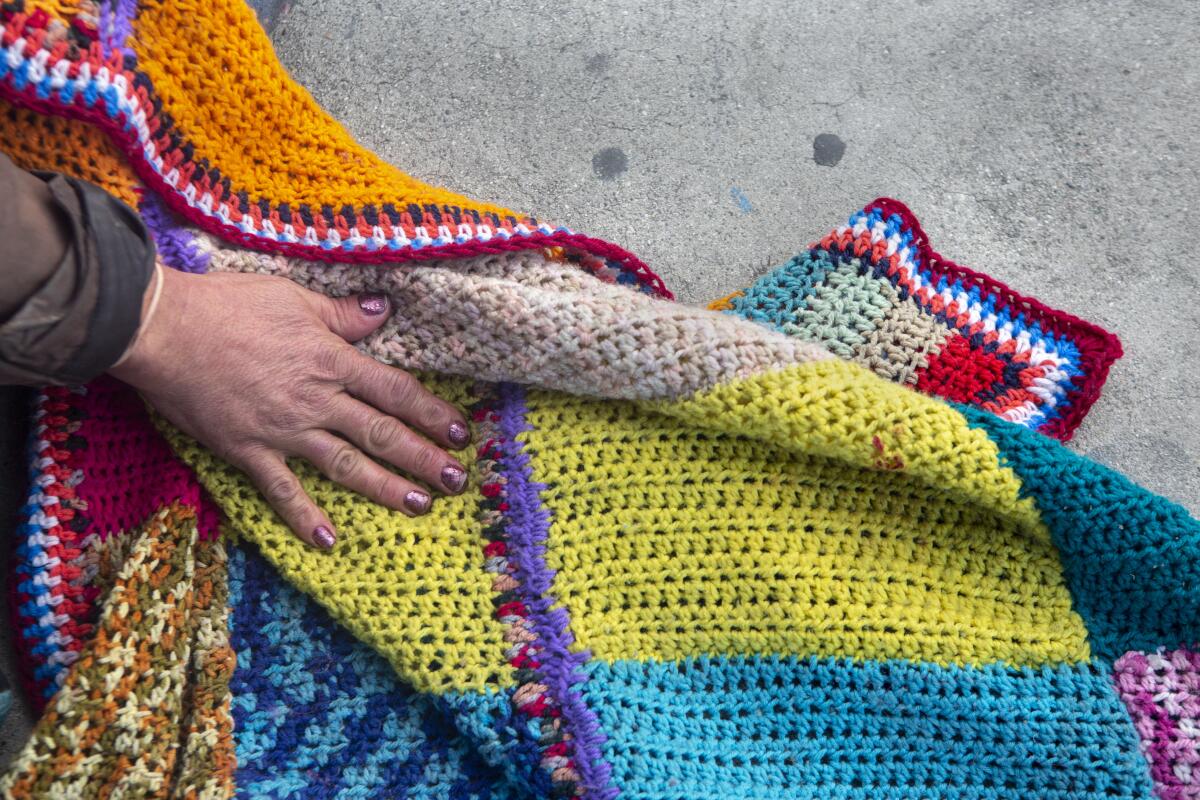
“Is there not something I need? Look at me. It’s January. Do you have a sweater? A jacket? Some boots? Give something,” said Denise Mulloy, 54.
Middle-class people, she said, get themselves new cars every few years. “Just give us the clothes you don’t wear.”
On the Laurel Canyon off-ramp of the 101, a 67-year-old holding a cardboard sign that read, “Homeless, Every little bit helps” made me alternately burst out laughing and want to weep as she responded to my inquiries and I watched the drivers of Mercedes and Porsches stare straight ahead, eyes flat, avoiding any contact with her.
What kind of help helps her most? What helps least? Do many people offer her aid? Are they kind?
On a practical front, said this woman born in Brooklyn, N.Y., who asked that I only use her first name, please spare her the Clif Bar passed out the car window. “I’ve never tasted anything so bad. They taste like cardboard,” Patti told me. Granola bars are better, she said, but not with hard peanuts. She’s missing too many teeth.
She’s often wary of the home-cooked leftovers, handed over — probably with the best intentions — by a stranger. And what’s she going to do with the giant trays left over from parties sometimes dumped in her underpass? Excess is hard with no refrigerator. Perishable food starts to rot. Honestly, she said, she’d prefer a gift card to pick up a meal, say at Subway or McDonald’s.
She’d appreciate the creature comforts of Camel 99s — she’s smoked for 57 years and isn’t quitting now, she said — and packets of cherry Kool-Aid to flavor her water. “And blankets are good in the winter and even in the summer, to lay on,” she said. “I don’t know if you ever slept on cement. It’s kind of hard, you know.”
I am an individual. I have individual needs. Unhoused people have them too. Start to ask them and they’ll tell you. They’ll be specific. Pet food for a dog. Sanitary pads. Loaded TAP cards to help them travel to the welfare office or a nonprofit that can provide them with showers and fresh clothes and a meal. On a larger scale, toilets and trash cans to help them live on the streets in a cleaner, more civilized way.
They’ll also tell you very clearly what they don’t want and don’t need from you.
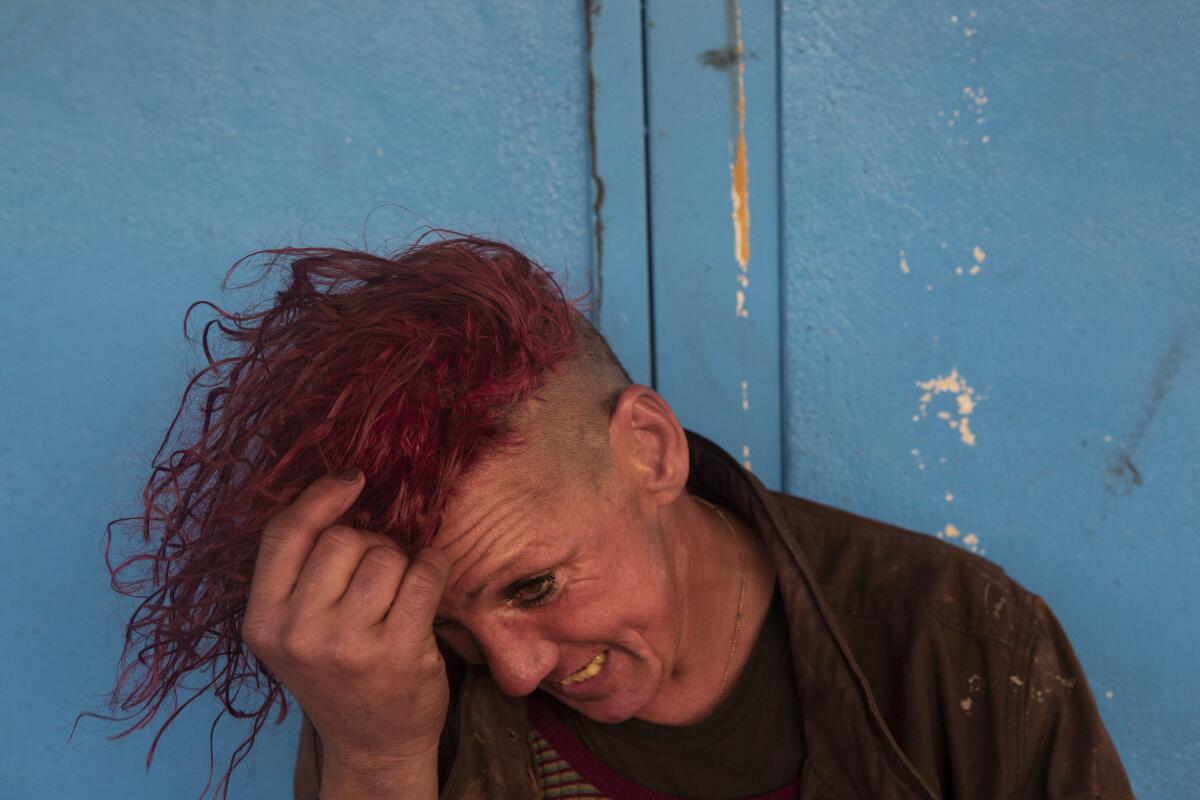
Sitting on the sidewalk outside a newsstand on Fairfax, Shannon Soole, 44, who might look tough at first glance but has sweet eyes and likes to crochet afghans, told me a lot of things that would be useful to her: medicine for headaches and colds and stomachaches. “A lot of us have trouble with our teeth. We need aspirin,” she said. Cans of tuna and chili are good.
But she’s not into the proselytizing people “who try to stomach punch you with AA.” She’s frank about her vices — mainly crystal meth — and not eager to face her current existence without them.
“Don’t hand me a piece of Bible literature. I’m quite aware of where I stand there,” Mulloy told me in Van Nuys. “I don’t need to read the Bible. I want an apartment. I want my own set of towels.”
Housing, of course, is first and foremost for most people. We’re getting more of it now — but it has been so slow and it won’t be able to keep up. We clearly have to advocate for more of it, faster, and for more structural and legal changes that will keep people from losing their shelter in the first place.
To that end, I watch with interest the efforts of Everyone In, a United Way-led campaign to get all Angelenos involved in the fight to solve our crisis of homelessness.
I admire the longtime nonprofits and the new grass-roots groups springing up around Los Angeles that both advocate for major societal change and go out on the streets week after week to try to make life better in smaller ways for those who won’t be seeing that big help anytime soon. I’m hoping that people will look at the models of such community groups as Ktown for All and the SELAH Neighborhood Homeless Coalition and be inspired to launch similar efforts in their own neighborhoods.
I recently watched a video of Ktown for All volunteers out on the streets of their own neighborhood, making contact with unhoused people, offering them help, listening to their needs. I was moved by how frankly they spoke about once being bystanders and then realizing they had to take individual action.
The video was made by Mark Horvath, who once was homeless on Hollywood Boulevard, and who started a nonprofit called Invisible People 11 years ago to document the stories of homeless people as a way to try to humanize, educate and shift perceptions and policy.
It was from Horvath that I got the idea to simultaneously ask about help and offer some. I drove around the city with photographer Gabriella Angotti-Jones, and we piled her back seat with bottles of water and granola bars and wet wipes and dozens of pairs of white crew socks.
Horvath brings white crew socks with him everywhere. Homeless people need fresh socks, he points out, to keep their feet warm and free from infections. And offering them socks is a shorthand way to indicate that you comprehend some of their experience.
For years, he’s talked about how joyful people often are to get the socks — which I never doubted but didn’t fully get until I gave them to people this week. “This is perfect,” said a young man in the alley off of Fairfax, whose eyes were very bloodshot and whose smell was rank. He had nothing, not a tent or a sleeping bag. He told me he just hid out at night in the bushes.
Horvath recently put together a primer about handing socks out, which contains useful advice. Among the key tips is one which I also would like to emphasize: “If you don’t feel safe, don’t engage with someone.” The young man off Fairfax was very high but gentle and exuding sadness.
I know a lot of people in the city have fears about homeless people — who in general live lives far more vulnerable than those of us with roofs over our heads. But there are certainly people on our streets who are unstable and behave erratically. Drugs and delusions and anger fueled by the hardness of life can do that.
I approached people politely and stated my aims clearly. I gave them space to decide whether or not they wanted to engage. Some clearly didn’t. Most did. Being homeless and ignored by many, after all, can be so lonely. It isn’t so often, I kept being told, that people want to hear about your thoughts and your life.
“This is the most talking I’ve done in so long,” Patti on the off-ramp told me after sharing stories about how she was an executive secretary for 26 years (103 words per minute on an electric typewriter, 65 on a manual) and about the guy who once drove behind her for blocks as she looked for cans and bottles at gas stations, handing her $280 in cash along the way because he said God had told him to.
She told me there’s competition for her off-ramp and she often doesn’t get to hold on to her spot for more than 45 minutes and sometimes her day of pan-handling brings in $1.50. She told me about the guy who likes to drive by her underpass very early in the morning and shout “GET UP!” and the people who routinely shout out their windows, “Get a job!”
“It’s nice to have somebody on my side,” she told me. “We don’t all throw bricks through your windows.”
At the start of our listening tour, Angotti-Jones and I were on the 101, taking in all the tents and lean-to’s tucked in on the slopes above the freeway. We backtracked to find one right near the Hollywood Bowl, in a fenced-off area at the end of a cul-de-sac that was anchored by a large, expensive Spanish-style home.
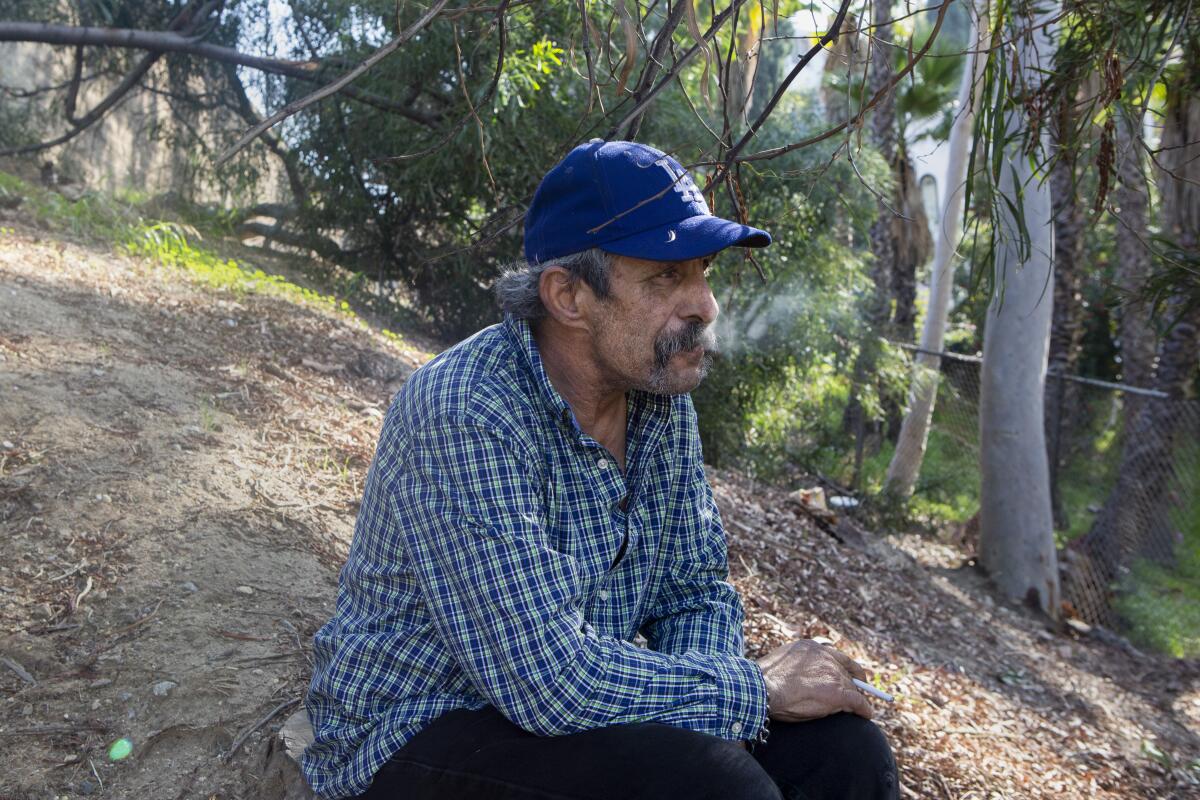
Beyond a hole in the fence, we found Mark Bizzarri, 61, who grew up in Montebello and used to have a trucking business before things went bad for him. He’s been out on the street since he was 50, he said, waiting on a list for housing for years.
Meanwhile, he hides his outdoor home out of sight behind the green fabric used for construction sites and cooks good meals, for himself and for some of the area’s younger denizens.
On the wish list of this man who describes himself as “houseless not homeless, because the world is my home”: real ingredients for cooking, things like potatoes and meat. Toilet paper. Full-time access to a nearby toilet.
I have my own lists now too. I plan to carry socks and TAP cards and clothes I no longer wear in my car.
More specifically, I need to go out and get food from the farmers market for Bizzarri, aspirin and wool for Soole, Kool-Aid and a soft blanket for Patti.
They used to be unknown to me, just those giant, flashing numbers. Now they’re people I can talk to and listen to and learn from and try to help.
More to Read
Sign up for Essential California
The most important California stories and recommendations in your inbox every morning.
You may occasionally receive promotional content from the Los Angeles Times.

